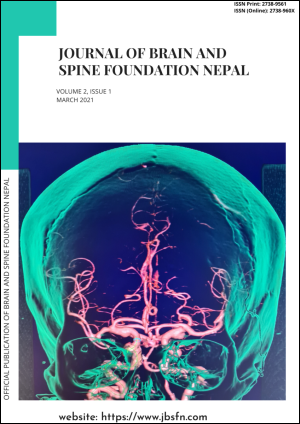A study of vasospasm in traumatic brain injury with subarachnoid hemorrhage
DOI:
https://doi.org/10.3126/jbsfn.v2i1.39012Keywords:
Transcranial Doppler ultrasonography, Traumatic brain injury, Intracranial vasospasm, Subarachnoid hemorrhageAbstract
Introduction: Cerebral vasospasm (CV) is common following subarachnoid hemorrhage (SAH). However, its impact on neurological outcome, especially in head trauma, has not been yet elucidated. Controversy exists about the true relationship between TBI, SAH and Traumatic Vasospasm. Hence, this study aims to determine the association of vasospasm in TBI with SAH.
Methods: This is Observational cross-sectional study with 124 head injury patients. 31 patients were excluded. Transcranial Doppler ultrasonography (TCD) was conducted on daily bases in all patients with traumatic brain injury (TBI). Vasospasm in the MCA and ACA was defined by a mean Flow velocity (FV) exceeding 120 cm/s and three times the mean FV of the ipsilateral ICA.
Results: Among 93 included patients, 72 (77%) were male and 21 (23%) were female. Mean age was (35+10) years. Mean GCS score was (11+4.1). 61 (66%) patients suffered with severe head injury. Vasospasm was detected in 45 % (42) of the total patients. Vasospasm was severe among 4.3% (4 patients), and moderate among 65.6% (61 patients). Association was found between severity of trauma and the severity of vasospasm in MCA (r= 0.41 and 0.38, p value< 0.005) and in ACA (r =0.25, p value < 0.005). The presence of SAH is highly correlated with an amplified incidence of vasospasm. The patients who developed vasospasm, 55% (23) had SAH whereas 45% (19) didn’t have SAH, the corresponding p value is 0.04 which is significant.
Conclusion: The high incidence of vasospasm is associated with SAH in severe TBI patients. Further studies are recommended to determine predictors of vasospasm in TBI patients with SAH.
Downloads
Downloads
Published
How to Cite
Issue
Section
License
Copyright (c) 2021 Shyam Babu Prasad, Suresh Bishokarma, Sagar Koirala, Dinesh Nath Gongal

This work is licensed under a Creative Commons Attribution 4.0 International License.

